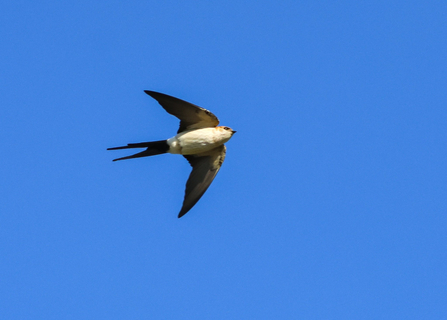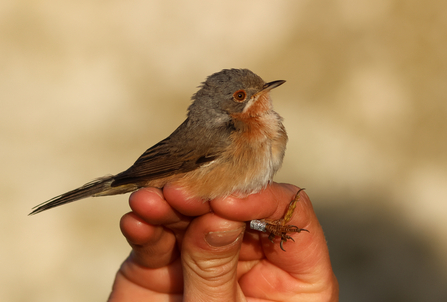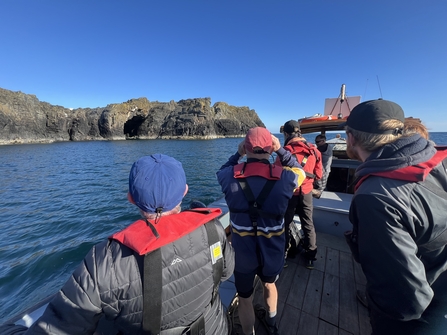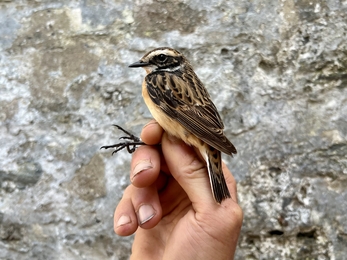On the bird migration front, May started well with 94 birds caught on the 1st, including the first Pied Flycatcher, Redstart and Spotted Flycatcher of the year. The latter was a Norwegian ringed Spotted Flycatcher, this being only the second Norwegian Spotted Flycatcher ever caught in Britain with three UK birds being trapped subsequently in Norway all from the Isle of May or North Ronaldsay! Other birds of note included a Cuckoo, a Blue Tit, two Whinchats and a Ring Ouzel. The Ring Ouzel remained the following day with a pair of Whinchat.
The 3rd held four Spotted Flycatcher, a Skylark, five Whimbrels and the Ring Ouzel with the first Garden Warbler of the year on the 5th alongside eight Spotted Flycatchers, two Whinchats, 96 Swallows, a Common Gull, two Swifts and the Ring Ouzel. The Ring Ouzel remained for the following two days with two Tree Pipits and three Spotted Flycatchers. A young male Pied Flycatcher was trapped on the 8th with a Tree Pipit, a Whinchat, eight Spotted Flycatchers, 12 Whitethroats and a Reed Warbler also logged. The first Dunlin of the year flew through the Sound on the 9th with the 10th having a Garden Warbler and two Reed Warblers in the nets. A quieter couple of days saw the odd Spotted Flycatcher, Sedge Warbler and Whitethroat logged.
Things picked up dramatically on the 13th when a Red-rumped Swallow was found by Ed circling the Observatory with a small flock of hirundines. Incredibly, this was the first for the Isle of Man and fortunately circled the Observatory area for around 15 minutes before heading north allowing the team to get great views! Alongside the Swallow, a Yellow Wagtail was in the Front Field, another first for the year, with 22 Spotted Flycatchers, a Whinchat, a Grasshopper Warbler, a Siberian Chiffchaff, a Swift, seven Common Scoters and a Ringed Plover also logged.

Red-rumped Swallow © Ed Betteridge
Another Yellow Wagtail went north the following day with a Reed Warbler and 11 Spotted Flycatchers recorded. The next day saw our second rarity of the week with a Western Subalpine Warbler trapped at the Observatory by Eleanor, with a Crossbill, a Tree Pipit and 14 Spotted Flycatchers also around the Island!

Western Subalpine Warbler © Ed Betteridge
A Lesser Whitethroat was trapped during the morning of the 16th with two Tree Pipits and two Reed Warblers logged. Another Lesser Whitethroat was trapped on the 17th with a Marsh Harrier hunting the Island and two Whinchats, however the highlight was the almost all white Hen Harrier that came across briefly during the morning. A Lapwing and a Collared Dove highlighted the 18th with a Dunlin and a Crossbill on the 19th. The 20th produced another Dunlin and a Garden Warbler. The following day produced a Lapwing, three Whimbrels, a Skylark and a Sand Martin. A productive 22nd had three year-ticks with a Barnacle Goose over, a Short-eared Owl hunting over the north end and a Sanderling at Cow. Five Crossbills were new in the next day with a Common Sandpiper and Grey Wagtail logged. The Short-eared Owl reappeared on the 24th with a seawatch on the 25th having 904 Manx Shearwaters, 16 Puffins and 1500 Auks. South-westerly winds then dominated and halted migration with a Whimbrel the only bird of note until a Short-eared Owl on the 29th and a few Spotted Flycatchers to end the month. In total, 100 bird species were recorded on the Calf in May.
The Ornithology Team were also been very busy monitoring the breeding birds throughout May. We conducted our first round-island trip to count seabirds in May. Stephen and Jack kindly took the Observatory Team out and around the whole of the Calf, which has allowed us to survey the coastline for seabirds in a more comprehensive manner than is possible from the land. During these trips, everyone gets a species to count and our seabird colonies are mapped, allowing us to monitor our seabird populations. The Team also once again headed over to Kitterland for biosecurity and breeding bird checks. The Ornithological Team headed out to count gull nests and look for breeding Eiders, and the Estate Team conducted Camera trap and Longtail Trap checks.

Counting the Calf's seabirds from the boat © Kate Fox
During May we welcomed this year’s Eider volunteer, Rebecca, who spent her days trapsing through the bracken and heather in search of Eider nests. By the end of May, the Ornithology Team had found 67 nests, well hidden among the vegetation with the female’s intricate plumage giving them exceptional camouflage. The Team put a lot of effort into catching as many of the females on nests as they could, adding to the long-standing dataset of our breeding Eider population. This included a female which was ringed in 2009; a new longevity record for the Calf! A few days later, another female from 2009 was also re-trapped at night, ringed only a few days later and narrowly missing a missing out on a new record. Before they headed up north to moult, a further six drake Eiders were caught on the night of the 26th. The first ducklings appeared towards the end of the month, with the females carefully leading them down to the sea before eventually taking them across the Sound to the main island for safety.
It's exciting news on the Water Rail front, with both pairs hatching chicks in early May! We’ve been enjoying seeing their antics on our camera traps, and occasionally have been lucky enough to catch a glimpse of the fluffy black chicks or hear them calling away.
Water Rail with three chicks © Calf Wardens
The Team have also done very well this year for finding nests of songbirds breeding on the Calf. A brood of Pied Wagtail chicks in the Puddle (one of four nests found) were the first Pied Wagtail pulli (chicks) to be ringed here since 2006, and the first to be colour ringed as part of our new project! Ed has also been putting a lot of effort into finding Wheatear nests, with over 30 nests located and over 100 pulli ringed so far. The first Chough chicks have also been ringed, however unfortunately it’s not looking too good for them this year based on the progress of the accessible nests, with only six chicks form three nests and another failed. Other pulli to be ringed included Rock Pipits, Stonechats, Meadow Pipits and Crows.
In the gull colonies lots of chicks have started to hatch, looking like little fluffy pebbles! With the good weather, Ed has had good success catching adults on the nests, with a Great Black-Backed Gull, five Lesser Black-Backed Gulls and 15 Herring Gulls. This allows us to colour ring them at their known breeding site which is really valuable data. Oystercatcher chicks are starting to pop out too, and we have a record number of Oystercatcher pairs this year! Many Shag nests also have chicks now, with the first broods ringed, and the first Razorbill chick was heard calling from its nest hole on the 30th.














